Petrology and geochemistry of the Mamakan gabbroic intrusions, Urumieh (Urmia), Iran: Magmatic development of an intra-oceanic arc
DOI:
https://doi.org/10.2451/2013PM0016Keywords:
Layered and massive gabbroic intrusion, hornblendite, fractional crystallization, subduction zone, island arcAbstract
The Mamakan gabbroic intrusions are located in the north of Sanandaj-Sirjan zone (SSZ). The intrusions injected to the Paleozoic platform of the central Iran at 303-298 Ma. These intrusions are divided into the layered and massive gabbros. The layered types consist primarily of gabbros, interspersed with lenticular bodies of anorthosite and hornblendites. The lenticular bodies show gradational or sharp boundaries with the gabbros. In the gradational boundaries, gabbros are mineralogically transformed into anorthosites, and/or hornblendites. On the other hand, where the boundaries are sharp, the mineral assemblages change abruptly. There is no obvious deformation in the Mamakan gabbroic intrusions. Hence, the changes in mineral compositions are interpreted as the result of crystallization processes, such as fractionation in the magma chamber. The massive types consist primarily of homogeneous gabbros.
The geological and age data show that the intrusions were formed from an Al-, Sr-, Mg-, Fe-enriched and K-, Nb-, Ta-, and P- depleted tholeiitic basaltic magma. The magma resulted from the partial melting of a metasomatized spinel peridotite wedge as a result of the start of Paleotethys subduction beneath Mamakan island arc. This island arc was developed over supra-subduction oceanic crust that occurred between the Gondwanaland and Paleozoic platform of the central Iran (south part of Eurasia). These results are proven by marked negative HFSE (P, Zr, Hf, Nb, and Ta) and positive Ba and K anomalies typical of subduction-related magmas.


